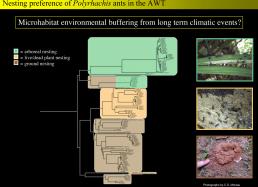8: Back in the Lab
Hello to all of you who are fans of the Australian rainforest and its resident ants! I promised that I’d get back to you with the results of my DNA research on the ant specimens I collected during my trip into the Australian Wet Tropics. By the way, I made a video about some of the environmental benefits of ants in the rainforest, so please take a moment to check out "Intro to Australian Ants."
After returning home, I and my collections assistant, Beka Baquiran, began the time-consuming task of unpacking the thousands of vials that traveled home with me. Upon close inspection of the specimens, it turns out that we collected hundreds of different species—a wonderful sampling of the diversity that can be found within the Australian Wet Tropics!
Beka then spent weeks preparing the specimens in several different ways: by pinning them for storage in the museum’s collections (for scientists to use now and hundreds of years from now), by preserving them in clean vials of alcohol, and by passing some along for DNA analysis. Preparing the specimens in this way provides a permanent record of the diversity found at each location visited during the expedition. Forevermore, scientists can use these collections to monitor population changes at those precise locations and also for comparison studies of similar species found in other parts of the rainforest.
As I mentioned, some specimens of each species made their way into the Pritzker Lab to be prepared for DNA analysis by my research assistant, Jesse Czekanski-Moir, and the other members of my team, Dr. Stefanie Kautz and Ben Rubin. To see how this process works, take a look at my video “Sequencing Ant DNA.”
Once the DNA analysis was complete, I then used the genetic sequence of each individual to fill in the family tree for each different ant species. As it turns out, DNA sequencing revealed the pattern I had discovered in my previous research—the diversity of ground-dwelling ant species saw steady growth during drying events, while tree-dwelling species dwindled down to many fewer species, whose populations didn’t expand and diversify until the rainforest had recovered. To learn more about my results, take a look at my “Climate Change & Ant DNA” video.
Understanding evolutionary patterns at such a fine scale and mapping where these patterns occur throughout Australia helps us not only locate the areas containing the highest amount of genetic diversity, but also target those areas facing the biggest threats.
And by understanding where in each ecosystem we can expect to see ant populations decline first, we can better predict the “domino effect” that might be experienced by plants, birds, reptiles, and other ant-dependant species. Armed with this information, we can design more effective conservation strategies to lessen the catastrophic effects of climate change. To support to our research and conservation efforts here at The Field Museum, I invite you to consider contributing a Restricted Gift to Zoology.
Again, thank you so much for following me into the field and back to the lab, and I hope you’ve enjoyed your expedition to the Australian Wet Tropics!
Until my next trip,
Dr. Corrie Moreau








